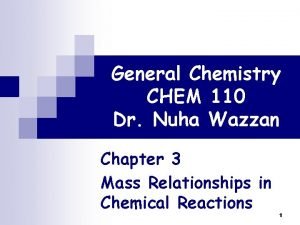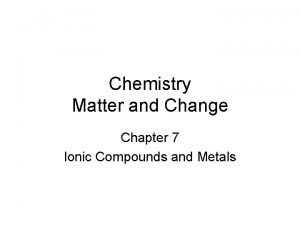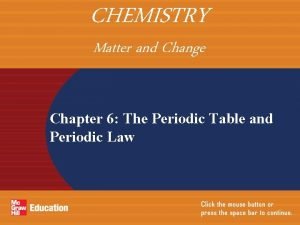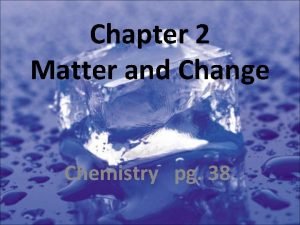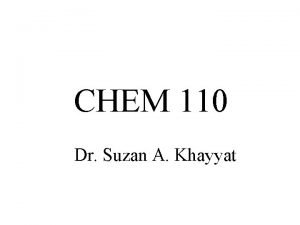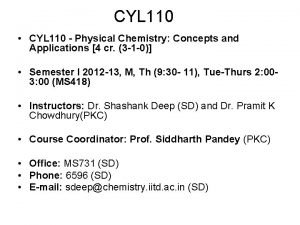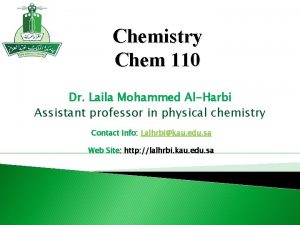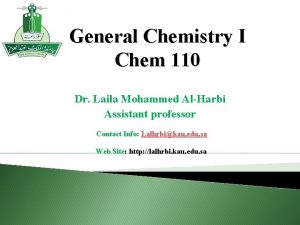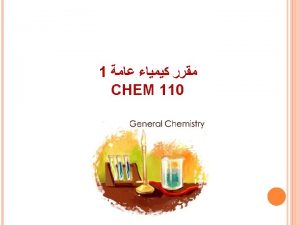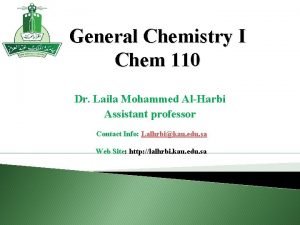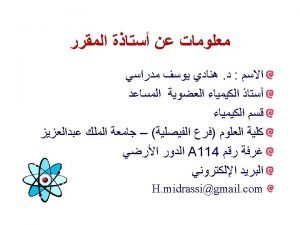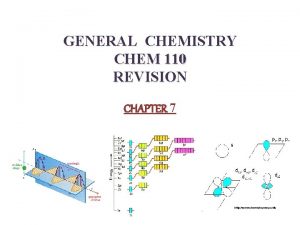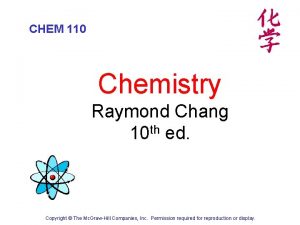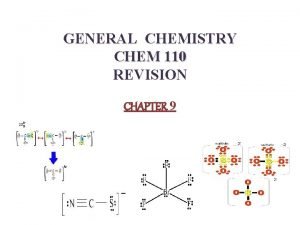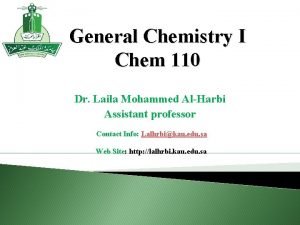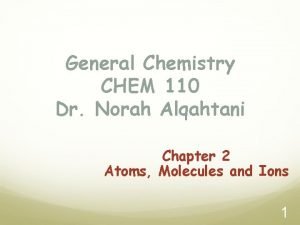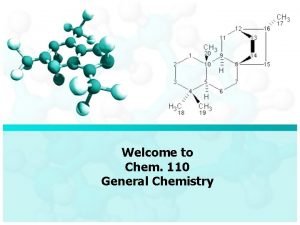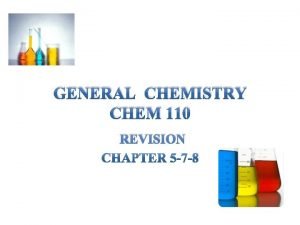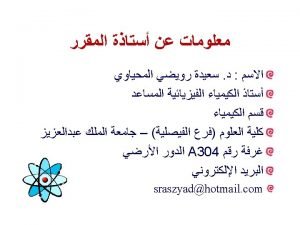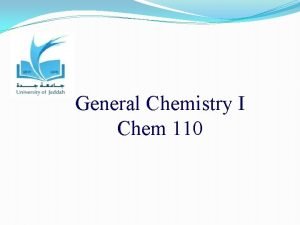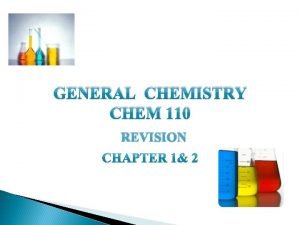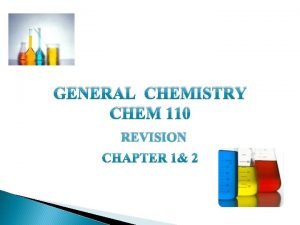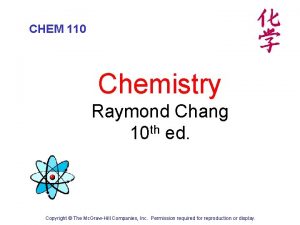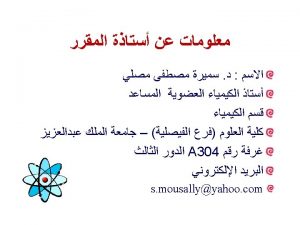Chem 110 Chemistry The Study of Change Copyright


































- Slides: 34


Chem 110 Chemistry: The Study of Change Copyright © The Mc. Graw-Hill Companies, Inc. Permission required for reproduction or display.

Chapter 1 ( P 11 -26 ) • Classifications of matter. • State of matter. • Physical & chemical properties. • SI units. • Temperature. • Scientific notation. • Signification figures. • Accuracy & precision. 1. 1

Chemistry is the study of matter and the changes it undergoes 1. Matter is anything that occupies space and has mass. 2. A substance is a form of matter that has a definite composition and distinct properties. Water Sugar Gold 1. 4

A mixture is a combination of two or more substances in which the substances retain their distinct identities. 1. Homogenous mixture – composition of the mixture is the same throughout. soft drink, milk, solder 2. Heterogeneous mixture – composition is not uniform throughout. cement, iron filings in sand 1. 4

Physical means can be used to separate a mixture into its pure components. distillation magnet 1. 4

An element is a substance that cannot be separated into simpler substances by chemical means. • 114 elements have been identified • 82 elements occur naturally on Earth gold, aluminum, lead, oxygen, carbon • 32 elements have been created by scientists technetium, americium, seaborgium 1. 4


A compound is a substance composed of atoms of two or more elements chemically united in fixed proportions. Compounds can only be separated into their pure components (elements) by chemical means. Water (H 2 O) Glucose (C 6 H 12 O 6) Ammonia (NH 3) 1. 4

Classifications of Matter 1. 4

The Three States of Matter gas liquid solid 1. 5

Physical or Chemical ? A physical change does not alter the composition or identity of a substance. sugar dissolving ice melting in water A chemical change alters the composition or identity of the substance(s) involved. hydrogen burns in air to form water 1. 6

Extensive and Intensive Properties An extensive property of a material depends upon how much matter is being considered. • mass • length • volume An intensive property of a material does not depend upon how much matter is being considered. • density • temperature • color 1. 6

Measurement mass – measure of the quantity of matter SI unit of mass is the kilogram (kg) 1 kg = 1000 g = 1 x 103 g weight – force that gravity exerts on an object weight = c x mass A 1 kg bar will weigh on earth, c = 1. 0 1 kg on earth on moon, c ~ 0. 1 kg on moon 1. 7

International System of Units (SI) 1. 7

1. 7

Volume – SI derived unit for volume is cubic meter (m 3) 1 cm 3 = (1 x 10 -2 m)3 = 1 x 10 -6 m 3 1 dm 3 = (1 x 10 -1 m)3 = 1 x 10 -3 m 3 1 L = 1000 m. L = 1000 cm 3 = 1 dm 3 1 m. L = 1 cm 3 1. 7

Density – SI derived unit for density is kg/m 3 1 g/cm 3 = 1 g/m. L = 1000 kg/m 3 mass density = volume m d = V A piece of platinum metal with a density of 21. 5 g/cm 3 has a volume of 4. 49 cm 3. What is its mass? m d = V m = d x V = 21. 5 g/cm 3 x 4. 49 cm 3 = 96. 5 g 1. 7

Worked Example 1. 1

Worked Example 1. 2

K = 0 C + 273. 15 273 K = 0 0 C 373 K = 100 0 C 9 0 C + 32 0 F = x 5 32 0 F = 0 0 C 212 0 F = 100 0 C 1. 7


Convert 172. 9 0 F to degrees Celsius. 9 0 C + 32 0 F = x 5 9 0 C 0 F – 32 = x 5 5 x (0 F – 32) = 0 C 9 5 0 C = x ( 0 F – 32) 9 5 0 C = x (172. 9 – 32) = 78. 3 9 1. 7

Chemistry In Action On 9/23/99, $125, 000 Mars Climate Orbiter entered Mar’s atmosphere 100 km (62 miles) lower than planned and was destroyed by heat. 1 lb = 1 N 1 lb = 4. 45 N “This is going to be the cautionary tale that will be embedded into introduction to the metric system in elementary school, high school, and college science courses till the end of time. ” 1. 7

Scientific Notation ﺍﻟﻌﻠﻤﻲ ﺍﻟﺘﺪﻭﻳﻦ The number of atoms in 12 g of carbon: 602, 200, 000, 000 6. 022 x 1023 The mass of a single carbon atom in grams: 0. 00000000000199 1. 99 x 10 -23 N x 10 n N is a number between 1 and 10 n is a positive or negative integer 1. 8

Scientific Notation 568. 762 0. 00000772 move decimal left move decimal right n>0 n<0 568. 762 = 5. 68762 x 102 0. 00000772 = 7. 72 x 10 -6 Addition or Subtraction 1. Write each quantity with the same exponent n 2. Combine N 1 and N 2 3. The exponent, n, remains the same 4. 31 x 104 + 3. 9 x 103 = 4. 31 x 104 + 0. 39 x 104 = 4. 70 x 104 1. 8

Scientific Notation Multiplication 1. Multiply N 1 and N 2 2. Add exponents n 1 and n 2 Division 1. Divide N 1 and N 2 2. Subtract exponents n 1 and n 2 (4. 0 x 10 -5) x (7. 0 x 103) = (4. 0 x 7. 0) x (10 -5+3) = 28 x 10 -2 = 2. 8 x 10 -1 8. 5 x 104 ÷ 5. 0 x 109 = (8. 5 ÷ 5. 0) x 104 -9 = 1. 7 x 10 -5 1. 8

Significant Figures ﺍﻟﻤﻌﻨﻮﻳﺔ ﺍﻷﺮﻗﺎﻡ • Any digit that is not zero is significant 1. 234 kg 4 significant figures • Zeros between nonzero digits are significant 606 m 3 significant figures • Zeros to the left of the first nonzero digit are not significant 0. 08 L 1 significant figure • If a number is greater than 1, then all zeros to the right of the decimal point are significant 2. 0 mg 2 significant figures • If a number is less than 1, then only the zeros that are at the end and in the middle of the number are significant 0. 00420 g 3 significant figures 1. 8

How many significant figures are in each of the following measurements? 24 m. L 2 significant figures 3001 g 4 significant figures 0. 0320 m 3 3 significant figures 6. 4 x 104 molecules 2 significant figures 560 kg 2 significant figures 1. 8

Significant Figures Addition or Subtraction The answer cannot have more digits to the right of the decimal point than any of the original numbers. 89. 332 +1. 1 90. 432 3. 70 -2. 9133 0. 7867 one significant figure after decimal point round off to 90. 4 two significant figures after decimal point round off to 0. 79 1. 8

Significant Figures Multiplication or Division The number of significant figures in the result is set by the original number that has the smallest number of significant figures 4. 51 x 3. 6666 = 16. 536366 = 16. 5 3 sig figs round to 3 sig figs 6. 8 ÷ 112. 04 = 0. 0606926 = 0. 061 2 sig figs round to 2 sig figs 1. 8

Significant Figures Exact Numbers from definitions or numbers of objects are considered to have an infinite number of significant figures The average of three measured lengths; 6. 64, 6. 68 and 6. 70? 6. 64 + 6. 68 + 6. 70 = 6. 67333 = 6. 67 = 7 3 Because 3 is an exact number 1. 8

Accuracy ﺍﻟﺪﻗﺔ – how close a measurement is to the true value Precision ﺍﻟﻤﺼﺪﺍﻗﻴﺔ – how close a set of measurements are to each other accurate & precise but not accurate & not precise 1. 8

Problems • 6 , 7 , 8 , 12 , 14 , 16 , • 22 , 23 , 26 , 30 , 32 , • 34 , 36 , 37 , 49 , 50 , 52.
 Vignette mutuelle 110/110
Vignette mutuelle 110/110 110 000 110 111 000 111
110 000 110 111 000 111 How to find one mole of a compound
How to find one mole of a compound Ib chemistry functional groups
Ib chemistry functional groups Organic vs inorganic chemistry
Organic vs inorganic chemistry 6 phase changes
6 phase changes Chemistry matter and change chapter 7
Chemistry matter and change chapter 7 Chemistry: matter and change chapter 10 the mole answer key
Chemistry: matter and change chapter 10 the mole answer key 1s 22 s22 p63 s23 p64 s2
1s 22 s22 p63 s23 p64 s2 Chemistry matter and change chapter 6
Chemistry matter and change chapter 6 Chemistry matter and change chapter 10 the mole answer key
Chemistry matter and change chapter 10 the mole answer key Chemistry matter and change answer key chapter 2
Chemistry matter and change answer key chapter 2 What is a phisical change
What is a phisical change Hình ảnh bộ gõ cơ thể búng tay
Hình ảnh bộ gõ cơ thể búng tay Bổ thể
Bổ thể Tỉ lệ cơ thể trẻ em
Tỉ lệ cơ thể trẻ em Voi kéo gỗ như thế nào
Voi kéo gỗ như thế nào Glasgow thang điểm
Glasgow thang điểm Hát lên người ơi
Hát lên người ơi Môn thể thao bắt đầu bằng chữ f
Môn thể thao bắt đầu bằng chữ f Thế nào là hệ số cao nhất
Thế nào là hệ số cao nhất Các châu lục và đại dương trên thế giới
Các châu lục và đại dương trên thế giới Công thức tiính động năng
Công thức tiính động năng Trời xanh đây là của chúng ta thể thơ
Trời xanh đây là của chúng ta thể thơ Cách giải mật thư tọa độ
Cách giải mật thư tọa độ 101012 bằng
101012 bằng độ dài liên kết
độ dài liên kết Các châu lục và đại dương trên thế giới
Các châu lục và đại dương trên thế giới Thơ thất ngôn tứ tuyệt đường luật
Thơ thất ngôn tứ tuyệt đường luật Quá trình desamine hóa có thể tạo ra
Quá trình desamine hóa có thể tạo ra Một số thể thơ truyền thống
Một số thể thơ truyền thống Cái miệng xinh xinh thế chỉ nói điều hay thôi
Cái miệng xinh xinh thế chỉ nói điều hay thôi Vẽ hình chiếu vuông góc của vật thể sau
Vẽ hình chiếu vuông góc của vật thể sau Nguyên nhân của sự mỏi cơ sinh 8
Nguyên nhân của sự mỏi cơ sinh 8


